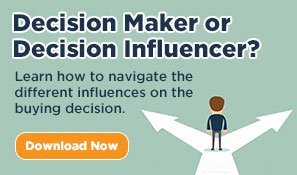
When selling a product or service, not all outreach efforts should be directed directly at the decision maker, who has the final word on what will be bought.
Instead, it's more effective to engage with the people around them—influencers from whom they seek advice, people nearby who can speak favorably about your company, and sources of information they trust.
This is an even more vital strategy in B2B sales efforts. After all, the decision maker may not be the one using your product, adjusting workflows to accommodate it, or even engaging with the product directly at all. Instead, your sales teams need to develop a comprehensive approach for identifying and engaging with influencers who will ultimately lead you to decision makers (or lead the decision makers to you).
Start by clearly understanding the role of decision influencers in today's sales and buying experiences, how to reach out to these decision influencers, and, ultimately, how to leverage that connection to get in front of decision makers more effectively.
The Role of a Decision Influencer
Every organization has final decision-makers and influencers. CFOs and directors who advocate for spending in key areas, directors who work with managers to solve holes in their organizational processes, and procurement leaders who lean on their staff to complete RFP processes and understand the needs of different departments. It's hard to sell successfully without appealing to both parties, and it's important to outreach to the influencers first.
Think of decision influencers as people who can't directly approve a purchase themselves but who have either an official or unofficial role in shaping the actual decision makers' thoughts, opinions, and final choices. They often act as the middle ground between what boots-on-the-ground employees need and what decision-makers and budget approvers can make happen. Not only do they see the pain points that your solution should address, but they also understand the internal politics and processes needed to get your solution approved.
You'll often find these decision influencers in:
- Procurement departments
- Managerial roles within the departments pertinent to your products and services
- RevOps and enablement teams
- Finance, as they can weigh the costs and value of your offerings
Engaging Decision Influencers Effectively
You know who decision influencers are and why they matter—but how do you act on this information? There are a couple of different strategies your sales teams can use:
- Consider account-based marketing and account-based selling.
Especially if you serve large enterprise organizations, prioritize personalized campaigns and outreach over broad outreach. Research a company to discover exactly who the influencers are—their names, roles, preferences, and likely challenges.
By creating entirely bespoke outreach strategies, you can tailor every conversation around the pain points you know they have and the capabilities you know they're looking for.
- Prioritize relationship-based sales.
Relationships matter. Position yourself as more of a consultant than a salesperson so your prospects can trust your advice and believe that you're offering the right products and solutions to achieve their objectives.
Rather than having a promotional pitch, have sit-down conversations where they explain their challenges, and you work with them to create plans that authentically address those challenges. These conversations establish trust. You can also gain far more insight into what matters to both the influencer and the decision-maker.
- Make sure the influencer continues to be part of the relationship.
It's tempting to let the influencer fade from sight once you make contact with the decision-maker or successfully sell to the company. But this is a mistake. Keep them in the loop so they stay excited about your products and feel involved in the big decision.
You're keeping your brand at the forefront of their mind and continuing to garner more insight into the client. Keeping that relationship strong also means a competitor can't move in and take your place.
Connecting With Decision Makers
Warm relationships with influencers eventually lead to an introduction with the actual decision-maker. This might be in-person or video meetings, or it might be in the form of your company making the list of finalists during an RFP.
Try to get a conversation when you can. Influencers can open the door to a meeting, set up in-depth conversations, and even secure a demo (which you already have all the answers for).
This relationship is key—not only do you have insight into the decision maker's preferences, but the influencer can also give you a soft introduction.
The Path Forward
By reaching out to influencers and creating strong relationships, your organization has more access to decision-makers. Here's how:
- You learn more about the company's specific pain points and needs.
- You have an advocate for your brand within the company, which can make you stand out better amongst competitors.
- You can better tailor your communications, demos, and offerings based on the influencer's understanding of the decision-maker's priorities.
But how can you start on this journey from your current position? Take these steps:
- Research prospective buyers. Identify influencers, gatekeepers, and decision-makers, and develop targeted communications for each one.
- Listen, don't sell. Influencers can't say 'yes.' Instead, you can keep the conversation focused on them so they can talk about challenges, discuss solutions, and focus on day-to-day aspects. When the sales pressure is off, you can build a stronger relationship, learn about the organization, and become someone they're happy to chat with.
Reach More Decision Makers by Engaging Decision Influencers the Right Way
Engaging with decision influencers is a critical step for B2B sales teams looking to reach key decision makers and close more deals. By taking the time to identify and build relationships with these influencers, you gain valuable insights into the company's challenges, needs, and internal dynamics.
This insider knowledge allows you to tailor your approach, messaging, and solutions in a way that resonates with both the influencers and the ultimate decision makers.





